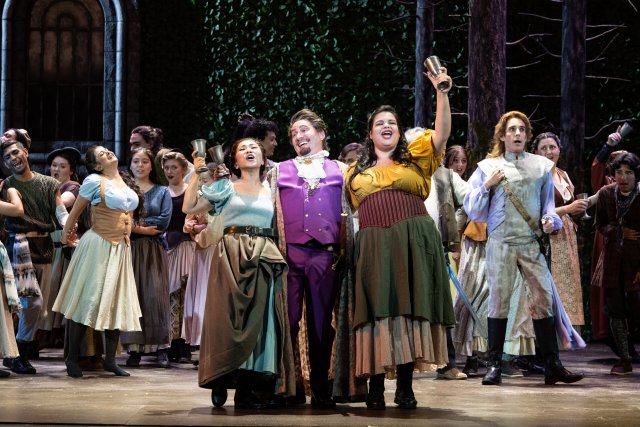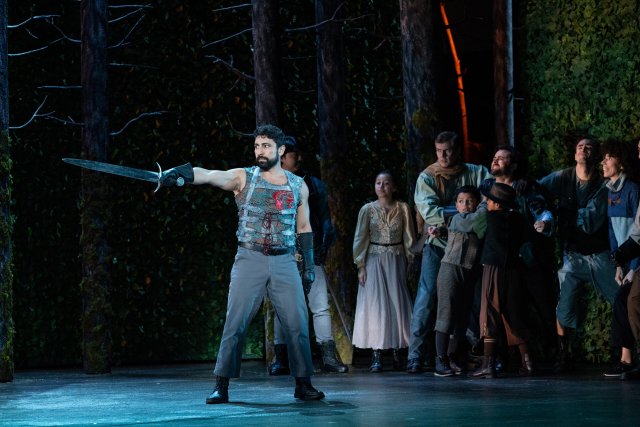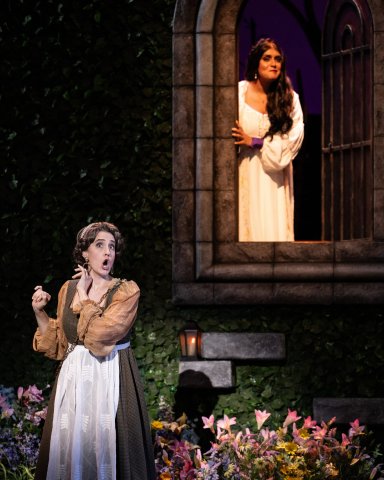Romeo and Juliet - Gounod's Opera
Fine Voices and Acting of Young Opera San Jose Cast Carry Opera
By: Victor Cordell - Sep 11, 2023
William Shakespeare’s play about star-crossed lovers was not the seminal work in its genre, but it is far and away the most profound and influential work of its kind, diminishing all pale imitators. Encompassing young love, warring factions, intermittent humor, and tragic death, its obvious grist for opera has prompted many efforts to adapt the masterpiece to the musical stage.
Of all operatic realizations, none compete with the accomplishment of Charles Gounod’s “Romeo et Juliet.” The style of the lush and romantic French language version was à la mode at its debut in 1867. Unlike many operas that draw from literary sources, its libretto hews closely to the original, capturing the drama intended by the playwright. Along with its fitting and beautiful music, many regard it among the greatest of the Shakespearian operas. Together with “Faust,” also taken from classic literature, this represents Gounod’s most accomplished and beloved work.
A rubric of many critics is that vital plot points should not be revealed in a review, but exceptions are allowed for classics, especially Shakespeare. In this case, the prologue telegraphs the outcome, eliminating the element of surprise. The lead photo herein depicts the climactic death scene of the lovers, but of course, you know that happens. In sum, the Capulet and Montague families are mortal enemies and members of each clan are killed by the other. The two lovers from the feuding families defy family strictures, and through tragic miscalculation they separately take their own lives.
Opera San Jose’s interpretation of “Romeo and Juliet” benefits from a passel of principals that are youthful enough to represent the roles they perform. What’s more, they bring their characters to life with great aplomb - singing and acting with exceptional skill. Despite the lack of surprise, the passion and anticipation make for a compelling drama.
The cast is led by Melissa Sondhi whose light lyric soprano suits the role of Juliet well. Juliet’s signature, and the most famous music from the opera, is her Act 1 aria about her lack of interest in marriage “Je veux vivre dans la rêve” (I want to live in dreams). She conquers its coloratura runs with delight and conviction. By Act 4, her voice has loosened and darkened, yielding an equally persuasive and more dramatic “Amour ranime mon courage” (Love drives my courage).
Tenor Joshua Sanders plays Romeo. Given his vocal skill, it surprises that this is his first lead role in an opera. Although his character is more active than Juliet’s, with sword fights and confrontations, Romeo is not given as much in the way of solo highlights. However, Sanders masters the Act 2 aria “Ah! Lève-toi soleil” (Rise, sun), with his trademark tremolo and slightly twangy Italianate vocal style. He also sings admirably in his street scenes and in the four wonderful duets with Juliet, which are largely written in one-singer-at-a-time style, but some contain charmingly complex polyphonic quodlibets. Although the tessitura of Romeo’s role is not high overall, he navigates the higher sections with particular skill and clarity.
“Romeo and Juliet” teems with distinctive secondary principals, and several will be mentioned, although all are accomplished. Two that die young and early in the action are Bay Area stalwarts that always acquit themselves laudably. Clarion tenor Alex Boyer is Tybalt, and warm and versatile baritone Efraín Solís is Mercutio. Courtney Miller as Juliet’s nurse Gertrude not only provides comic relief, but an admirable mezzo voice. Robert Balonek as Count Capulet once again demonstrates an uncommonly powerful and well-tuned instrument and acting skill that transitions from ebullient to grim over the course of the drama. Finally, the distinguished Kenneth Kellogg performs the cameo role of the Duke of Verona with great command and gravitas.
The opera’s narrative is more than a simple love story. It is about the tragic consequences of irrational tribalism; the inevitability of fate (though most would dispute that “fate” exists); the notion that love may cause unintended and undesired consequences; and the importance of time and timing in the affairs of humankind. Of course, one of the central issues concerns Juliet’s rebellion from being forced to marry Paris in order to solidify a political alliance. This aspect resonates much differently today than in the time of the original play or the opera, as women’s agency over marriage decisions has become accepted in many societies.
Opera San Jose has added a thematic dimension in the unsung portion of the prologue. After the clans engage in sword fighting, children make believe they are doing the same – sadly conveying the notion of violence being transmitted from one generation to another by example.
Another interesting aspect of OSJ’s production is Antara Bhardwaj’s Indian influenced dance choreographed to Gounod’s ballet sequences. One that doesn’t enhance the viewing experience is the set design, which seems driven more by budget than artistry. The same inexplicable vine covered backdrops appear through the first three acts and become a bedroom wall in Act 4. The simple and static nature of the set creates a more concert-version sense of the production. Happily, the book, the score, and performances make for a highly entertaining experience.
“Romeo and Juliet,” composed by Charles-François Gounod; with libretto by Jules Barbier and Michel Carré; and based on William Shakespeare’s play of the same name is produced by Opera San Jose and presented at California Theatre, 345 South 1st Street, San Jose, CA through September 24, 2023.





